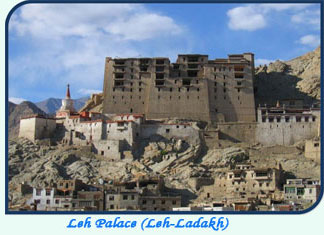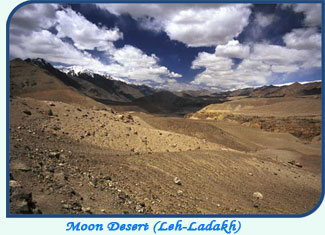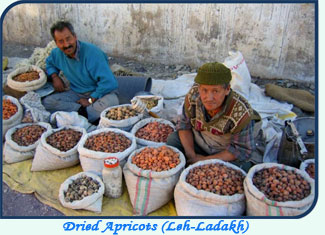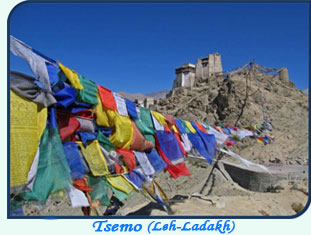Leh - Capital of Ladakh...  Leh is the Capital of the Ladakh, and the largest town of the region. It is located to the north of the Indus River at an elevation of 3600m above the sea level. The town is dominated by the nine-storey Namgyal Palace and Namgyal Tsemo (victory peak), built by Tashi Namgyal on his victorious in reunification of the Upper and Lower Ladakh. Leh became the capital of Stod (upper Ladakh) during the reign of king Graspa Bum- Lde,who ruled Ladakh from 1400 to 1430 AD.
Leh is the Capital of the Ladakh, and the largest town of the region. It is located to the north of the Indus River at an elevation of 3600m above the sea level. The town is dominated by the nine-storey Namgyal Palace and Namgyal Tsemo (victory peak), built by Tashi Namgyal on his victorious in reunification of the Upper and Lower Ladakh. Leh became the capital of Stod (upper Ladakh) during the reign of king Graspa Bum- Lde,who ruled Ladakh from 1400 to 1430 AD. In the later period, Leh became an important center for trade in Central Asia.  Leh remained merely a headquarter of Ladakh district until 1974, when Ladakh was opened for foreign tourists. Since then period Leh became the centre for tourism related activities in the region. Leh remained merely a headquarter of Ladakh district until 1974, when Ladakh was opened for foreign tourists. Since then period Leh became the centre for tourism related activities in the region.
A land of freezing winds and burning hot sunlight, Ladakh is a cold desert lying in the rain shadow of the Great Himalayas and other smaller ranges. Little rain and snow reaches this dry area, where natural forces have created a fantastic landscape. Surrounded by rugged mountains this land is completely different from the green landscape of many parts of the Himalayas. Bounded by two of the world's mightiest mountain ranges, the Great Himalaya and the Karokaram, it is a land which has no match. History of Leh King Sengge Namgyal who ruled Ladakh during 17th century and during whose rule Ladakh was at its greatest shifted his court from Shey to Leh.  Leh became the regional capital and very soon the town blossomed into one of the busiest markets on the Silk Route. Leh became the regional capital and very soon the town blossomed into one of the busiest markets on the Silk Route.During the 1920s and 1930s, the broad bazaar that still forms its heart received more than a dozen pony- and camel-trains each day. About Leh Leh has nonetheless retained a more tranquil side, and is a pleasant place to unwind after a long bus journey. Attractions in and around the town itself include the former Palace and Namgyal Tsemo Gompa, perched amid strings of prayer flags above the narrow dusty streets of the Old Quarter. A short walk north across the fields, the small monastery of Sankar harbours accomplished modern Tantric murals and a thousand beaded Avalokitesvara deity. 
Leh is also a good base for longer day trips out into the Indus Valley. Among the string of picturesque villages and Gompas within reach by bus are Shey, site of a derelict 17th century palace, and the Spectacular Tikse Gompa. Until one has adjusted to the altitude, however, the Only sightseeing one will probably feel up to will be from a guesthouse roof terrace or garden, from where the snowy summits of the majestic Stok-Kangri massif (6,120m), magnified in the crystal clear Ladakhi sunshine, look close enough to touch. More About Ladakh...  |